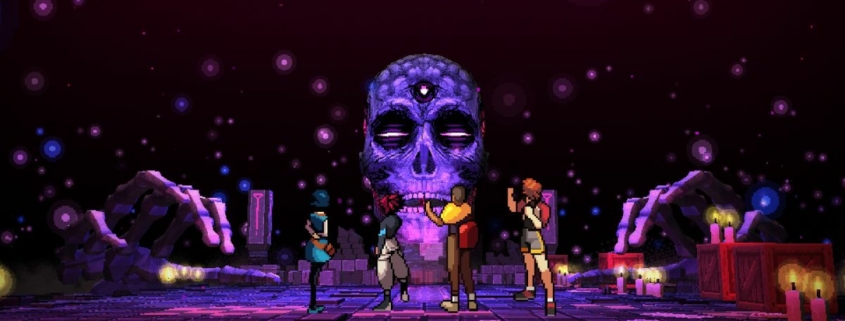Demonschool is a Persona-like tactical RPG about fast, frantic combat




My time at university was a mixture of wasted lectures and too many nights out, but at least I can say I didn’t have to fight shrieking monsters or risk getting dragged into a demonic realm. Though perhaps that would’ve been preferable given how slickly entertaining Demonschool (opens in new tab) makes it.
The game streamlines the combat of tactics RPGs and wraps it up in a story of students navigating the perils (supernatural or otherwise) of university life. Speaking with Creative Director Brandon Sheffield, it’s clear that it’s a game with a wealth of influence. “People compare it to Persona, Shin Megami Tensei and stuff… there was like Devil Survivor which was an SMT game, that was influential, a little bit with the relationship system… but the influences were much further flung and more from the cinematic and music sides. So it’s great that this grab bag of things I like has come together into something that people actually wanna look at.”
You play as Faye, who comes from a family of the last demon hunters, which essentially makes her a Belmont. Basically, she just loves to punch things and that makes her a girl after my own heart. Faye has begun university on a mysterious island along with a party of friends. Together they’ll need to balance the demands of higher education with the danger of higher powers.
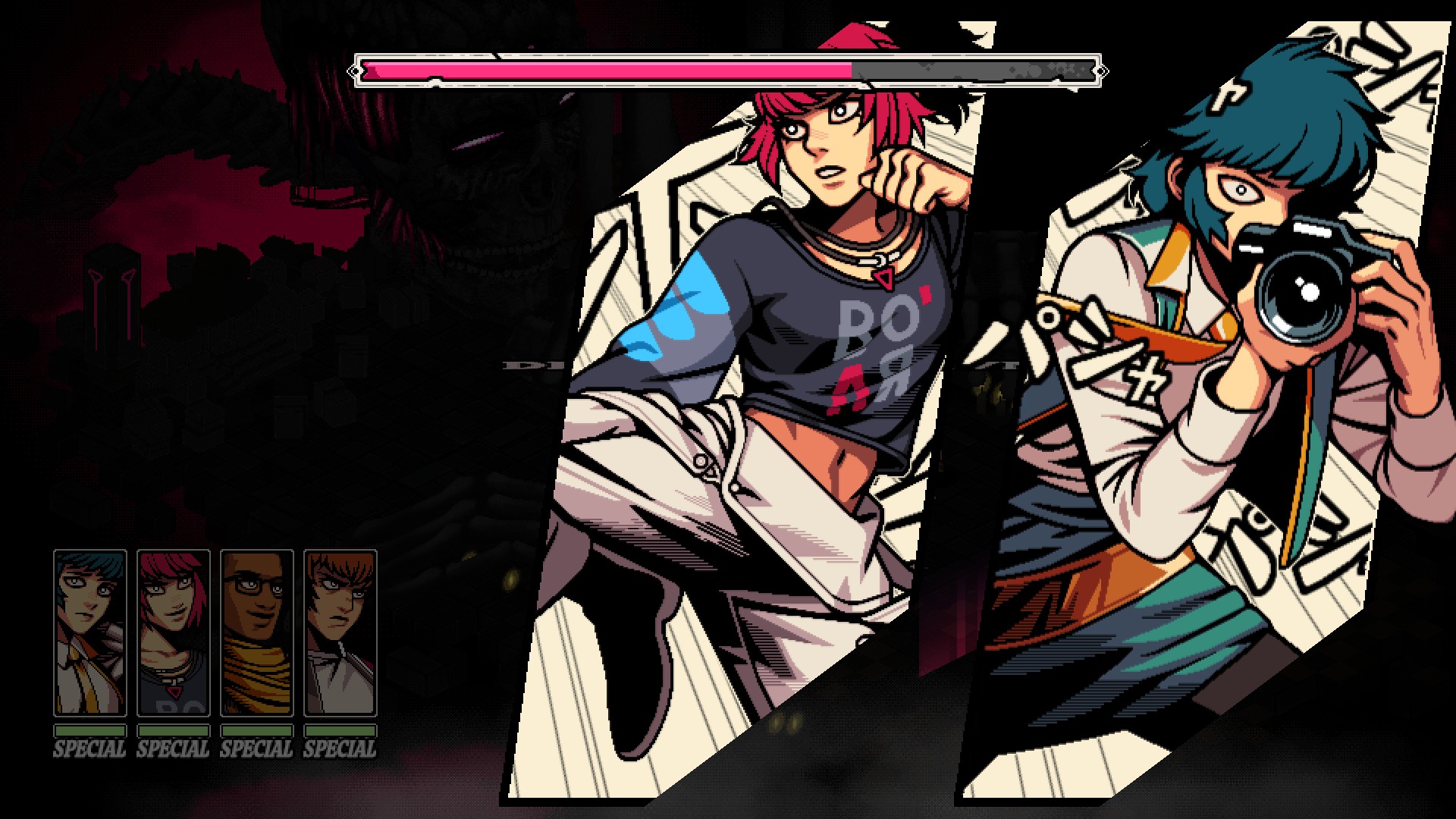
Cue possessed students, mysterious memory loss and…Yakuza?
Gameplay Demo-n
The demo I played featured a handful of combat encounters and a bit of the downtime between, both of which are very promising. Even just aesthetically it’s such a pleasing world to be in, with lovingly detailed environments and enchanting transitions. The human world is represented in 2D, with your characters and NPCs as sprites; the demon world and its most monstrous inhabitants are 3D. Eerily, the school itself is somewhere between the two, a 3D space presented as 2D, a sign of its supernatural corruption. As a visual effect it’s eye-catching as hell, but that there’s some meaning to the stylistic flair really gives Demonschool some teeth.
What a world it is too. Its demon inhabitants are lurid creations that can explode into gore and viscera. The game is never out-and-out horror but there’s a genuinely unsettling quality to its monsters, and atmosphere that gives it an edge. A sense of danger that heightens the stakes for your team, a party of four but with 15 characters to recruit, and makes each mystery they confront feel life or death. Demonschool draws on horror manga like the works of Suehiro Maruo and Junjji Ito, but also Italian horror cinema—and it’s a truly potent blend.
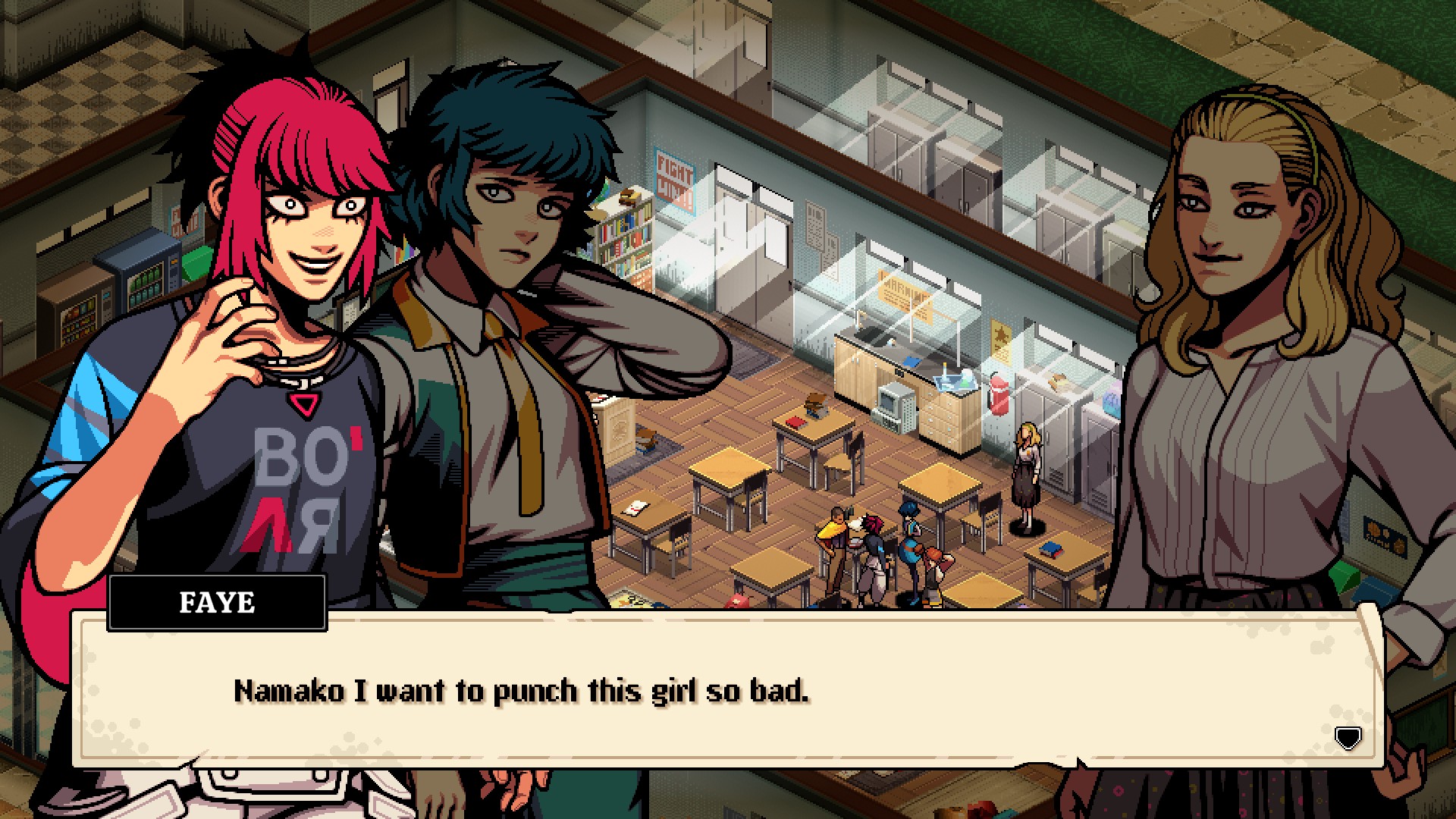
“The films of Lucio Fulci are a big influence, so like City of the Living Dead, The Beyond, Psychic and all those have music by Fabio Frizzi who is a big music influence on us…There’s also touchstones like Suspiria.”
The demo didn’t offer a long look of how the Persona-esque downtime will play out, but the sampling was promising. You explore the titular school as well as the surrounding island, traipsing through everything from classrooms to graveyards. There’s even a customisable clubhouse where you and your team can hang out, with an unlockable mini-game. Brandon also mentioned the final game will have fishing too, so you know this is a good and proper RPG.
Side quests litter the world, with progression tied to certain times of day, but only main quests push time forward (with a slick title card and blast of lighting). There doesn’t seem to be a lot of tension in choosing how to spend your time, as far as I was shown, but certainly, a more relaxed and less time-sensitive pace will suit many. However, there are dialogue choices to be made, where you can side with one of your companions over another, which levels up your relationship with that character. You’ll have to choose carefully too, since I’m told the game’s endings are determined by those relationships. Brandon says the game will contain around 15-20 hours of main quests, with the overall playtime likely to double if you chase down all the side quests. Which is quite the satanic offering.
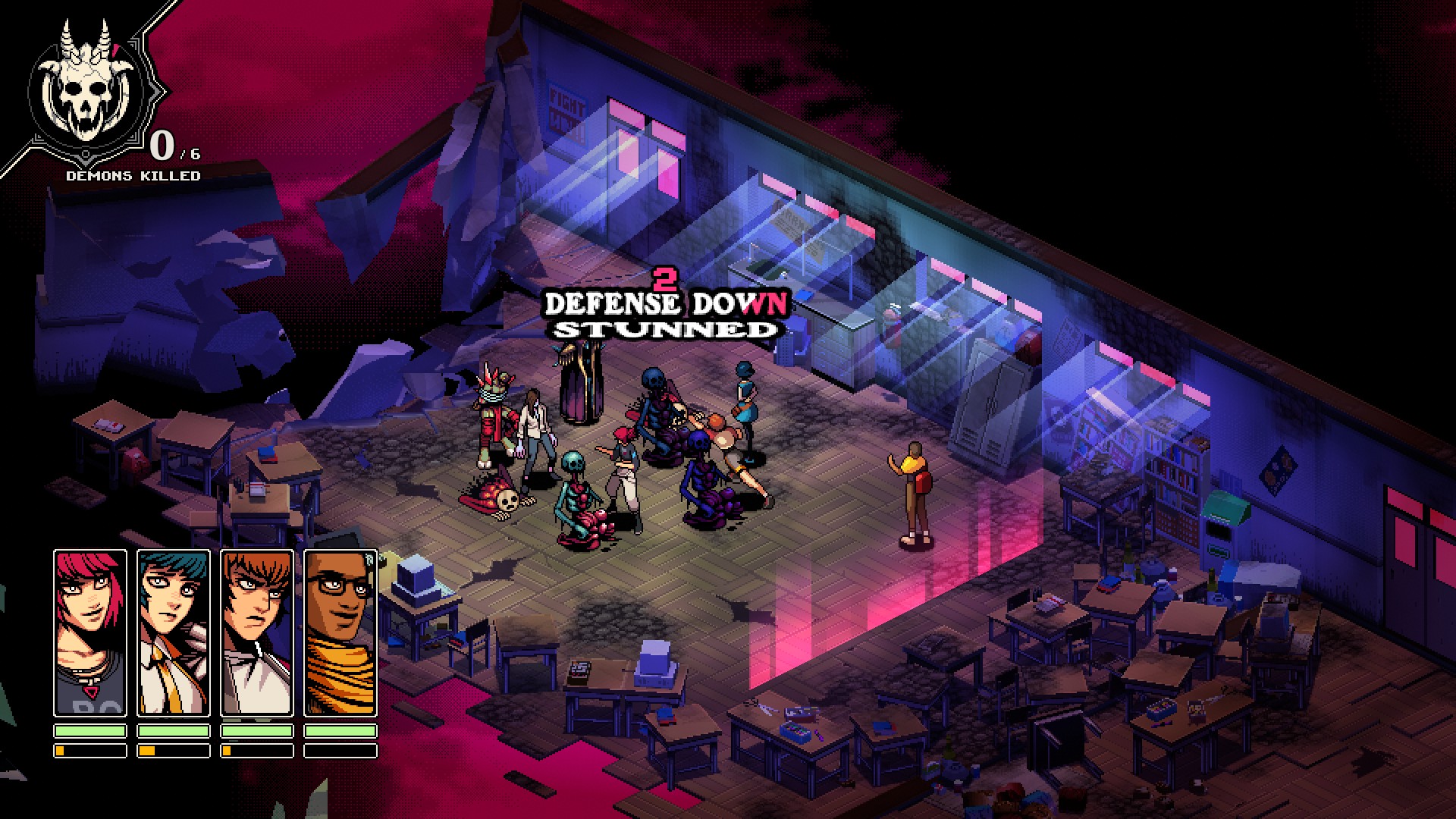
All of which is only one half of this game about two worlds, with the rest of the player’s time to be spent in tactical turn-based combat. Combat is broken into two phases: planning and action. In planning, you pick a character and choose where they’re going. If it’s a square with an enemy, they attack, if not, they move. Simple. Each character has their unique ability, as well as a special. Every character is pulling from the same pool of action points, so rather than one character at a time, your team goes all at once in the action phase, then the demons get their turn all at once. It gives combat a gripping speed, especially for someone like me who’s easily bored by slow strategy. Demonschool’s fights had me captivated.
Hell Bruiser
The secret sauce is in the synergy of its characters’ simple abilities. With 15 characters, a huge part of the game is finding the combinations that work for you. In the demo, one satisfying pair up is anxious Namako, who can stun enemies as she passes through them, with brawling himbo Destin. Not only does Namako stun, she nudges enemies a square behind in her wake. With this you can line up enemies for Destin, who can punch multiple enemies provided they’re in a row. It’s slick but pretty straightforward. The complications come in when you have limited action points for your party, and a whole host of demons to contend with. Keeping folk out of danger while staying on the offensive is key. The game will even reward you with more loot the more efficient you are with your moves.
The secret sauce is in the synergy of its characters’ simple abilities.
“[We are] making a tactics game that is efficient with players’ time. Reducing the number of clicks and making all choices really clear—making you able to fast forward or rewind.”

The mission statement of Demonschool, then, is to get into the action faster, and that’s true for its story as well as its combat. It strips out the faff and fuss—a goal with a surprising inspiration.
“In terms of pacing, [mangas] Chainsaw Man and Jujutsu Kaisen are also influences, because I like how they just get straight in to action and story. They make really excellent use of character tropes,” says Brandon. “Writers have a tendency to feel the need to explain everything before it even happens. So I’m using those as touchstones to force myself to not do that.”
The primary showcase of all this was the demo’s boss fight, with a screeching, giant 3D skeleton whose brain explodes from its skull as an attack. While it deploys minions to fight you, it also smashes down with fingers and swipes with its arms, meaning you need to keep your party clear of those incoming attacks while you dish out the damage. It teeters on the edge of overwhelming, in the best way, as you scramble to come up with the perfect set of moves to keep you ahead. Mitigating the stress is a generous undo button, letting you easily tinker with a strategy and then bail if you realise a better move is possible. It can’t roll back an entire phase, but it gives you plenty of breathing room while you plan each turn.
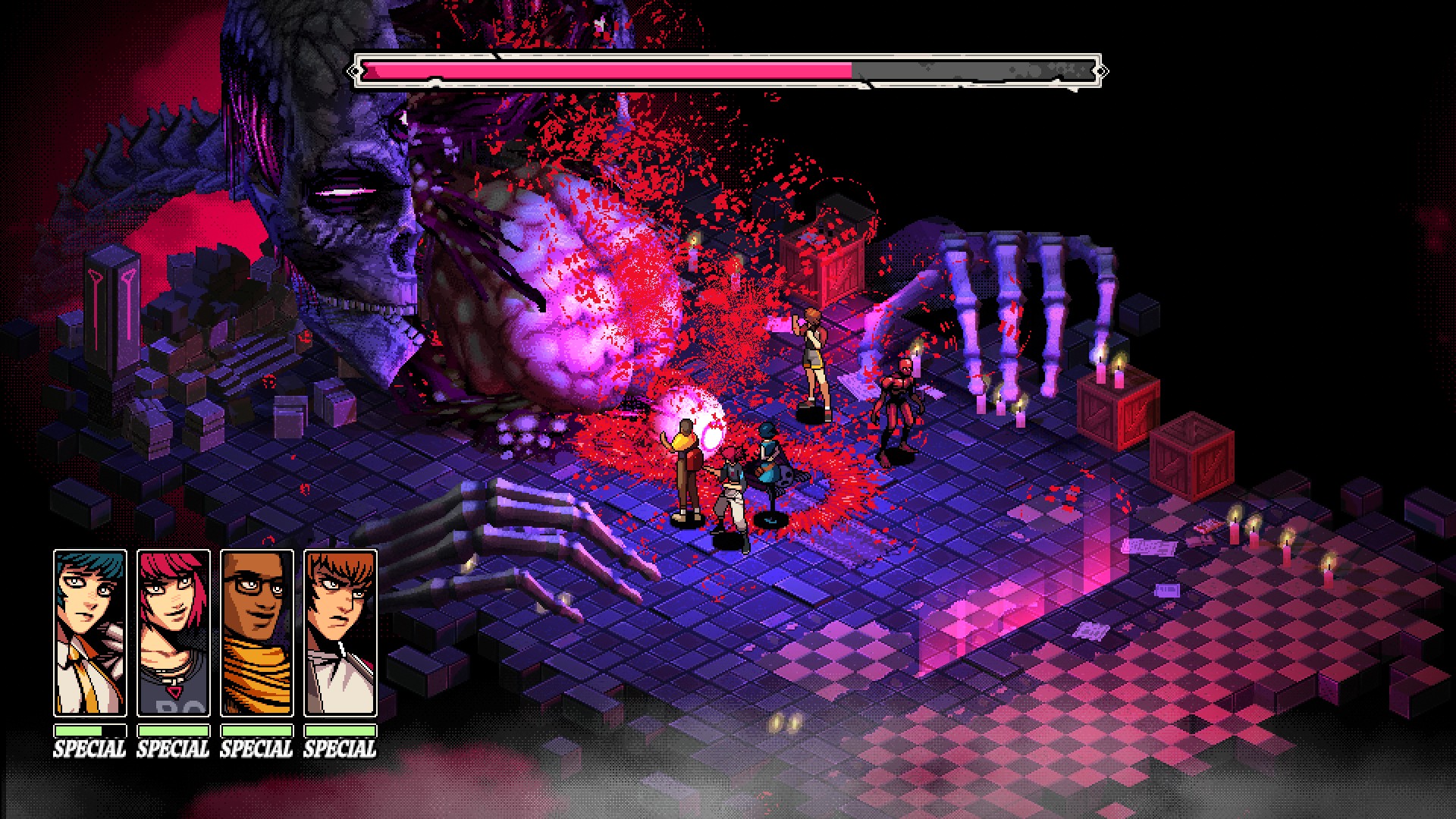
Once you’ve made your choices, you’re rewarded by getting to see it all play out in one go, and there’s a lovely rhythm to that. It’s like setting up a movie scene and then shouting ‘action!’. Get two characters working as a combo and you’re even treated to special, stylish cutaway before you watch them explode a demon in a shower of ichor.
Demonschool revels in simplicity, making the most out of everything it’s doing instead of adding on the illusion of depth with menu screens full of options. Things are kept slick and clear. I finished the demo eager to play more, and I just know that this is going to grab people as the perfect thing to luxuriate in over a month, one lunchtime battle or two at a time—like Into the Breach with spooky teens. School is in, and today, class, we’ll be learning all about kicking demon ass.
Source link

